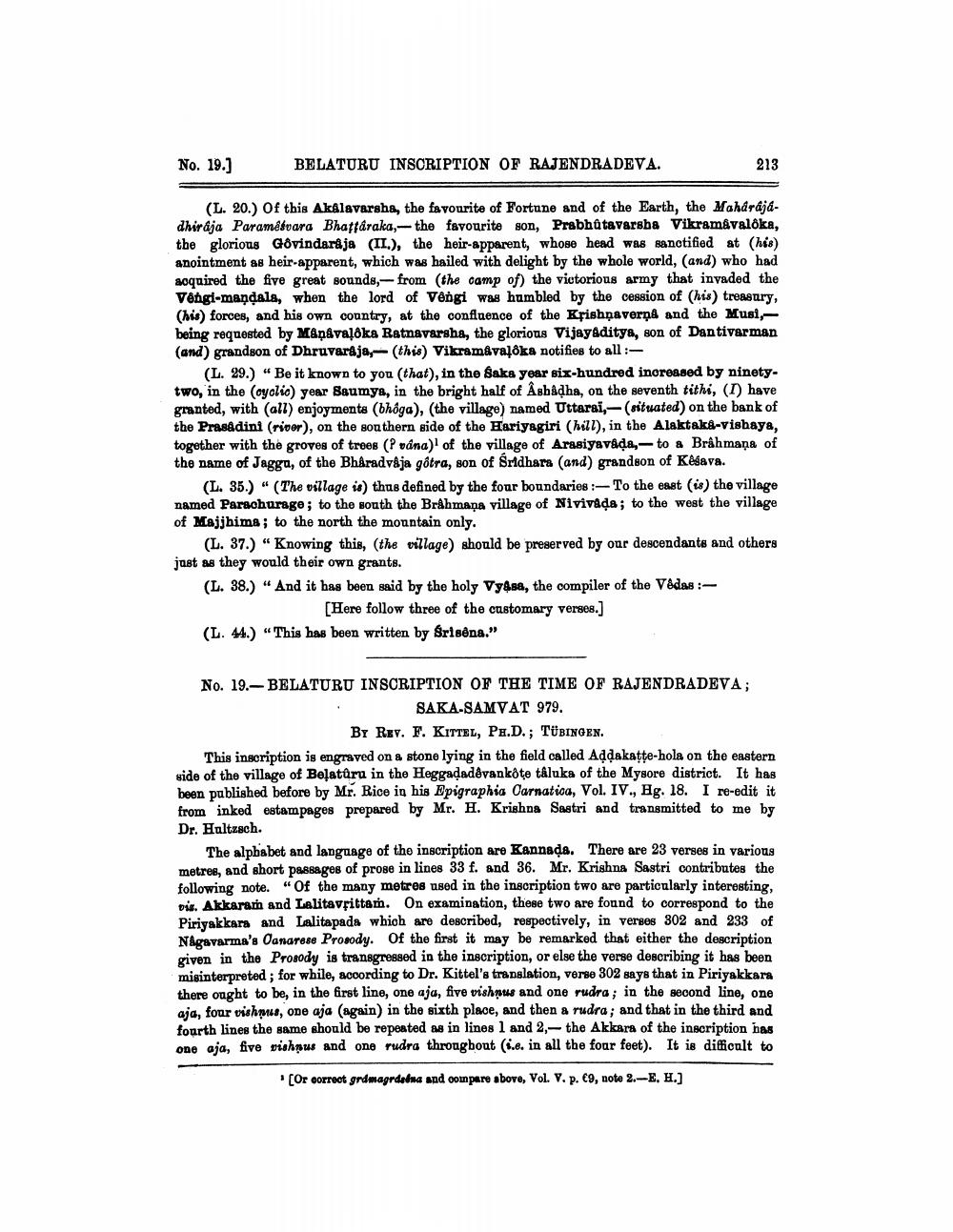________________
No. 19.)
BELATURU INSCRIPTION OF RAJENDRADEVA.
213
(L. 20.) Of this Akalavarsha, the favourite of Fortune and of the Earth, the Maharajadhiraja Paramêsvara Bhaffaraka,- the favourite son, Prabhûtavarsha Vikramávalóka, the glorious Govindaraja (IL.), the heir-apparent, whose head was sanctified at (his) anointment as heir-apparent, which was hailed with delight by the whole world, (and) who had acquired the five great sounds, from the camp of) the victorious army that invaded the Vêngi-mandala, when the lord of Vengi was humbled by the cession of (his) treasury, (his forces, and his own country, at the confluence of the Krishnaverna and the Musi, being requested by Manivalka Ratnavarsha, the glorious Vijayaditya, son of Dantivarman (and) grandson of Dhruvaraja-(this) Vikramávalóka notifies to all :
(L. 29.) “Be it known to you (that), in the Saks year six-hundred increased by ninetytwo, in the (cyclio) year Saumya, in the bright half of Åsbadha, on the seventh tithi, (I) have granted, with (all) enjoyments (thôga), (the village) named Uttarai,- (situated) on the bank of the Prasadini (river), on the southern side of the Hariyagiri (hill), in the Alaktaka-vishaya, together with the groves of trees (P vana)' of the village of Arasiyaváda, -to & Brâhmaņa of the name of Jagga, of the Bharadvềja gôtra, son of Sridhara (and) grandson of Kesava.
(L. 35.) 4 (The village is) thus defined by the four boundaries :- To the east (is) the village named Parachurage; to the south the Brahmana village of Nivivada; to the west the village of Majjhims; to the north the mountain only.
(L. 37.) " Knowing this, (the village) should be preserved by our descendants and others just as they would their own grants. (L. 38.) " And it has been said by the holy Vysa, the compiler of the Vedas :
[Here follow three of the customary versos.] (L. 44.) "This has been written by Srishna."
No. 19.-BELATURU INSCRIPTION OF THE TIME OF RAJENDRADEVA;
SAKA-SAMVAT 979.
By Rev. F. KITTEL, PH.D.; TÜBINGEN. This inscription is engraved on a stone lying in the field called Addakatte-hola on the eastern side of the village of Belatura in the Heggadadêvankote tâluka of the Mysore district. It has been published before by Mr. Rice in his Epigraphic Carnatioa, Vol. IV., Hg. 18. I re-edit it from inked estampages prepared by Mr. H. Krishna Sastri and transmitted to me by Dr. Haltzsch.
The alphabet and language of the inscription are Kannada. There are 23 verses in various metres, and short passages of prose in lines 33 f. and 36. Mr. Krishna Sastri contributes the following note. “Of the many metres used in the inscription two are particularly interesting, Dig. Akkaran and Lalitavfittam. On examination, these two are found to correspond to the Piriyakkars and Lalitapada which are described, respectively, in verses 302 and 233 of Nagavarma's Oanarese Prosody. Of the first it may be remarked that either the description given in the Prosody is transgressed in the inscription, or else the verse describing it has been misinterpreted; for while, according to Dr. Kittel's translation, verse 302 says that in Piriyakkara there ought to be in the first line, one aja, five vishnus and one rudra; in the second line, one aja, four vishmus, one aja (again) in the sixth place, and then a rudra; and that in the third and fourth lines the same should be repeated as in lines 1 and 2,- the Akkara of the inscription has one aja, five vishnus and one rudra througbont (i.e. in all the four feet). It is difficult to
(Or correct grdmagrdohna and compare above, Vol. V. p. €9, note 2.-E. H.)




